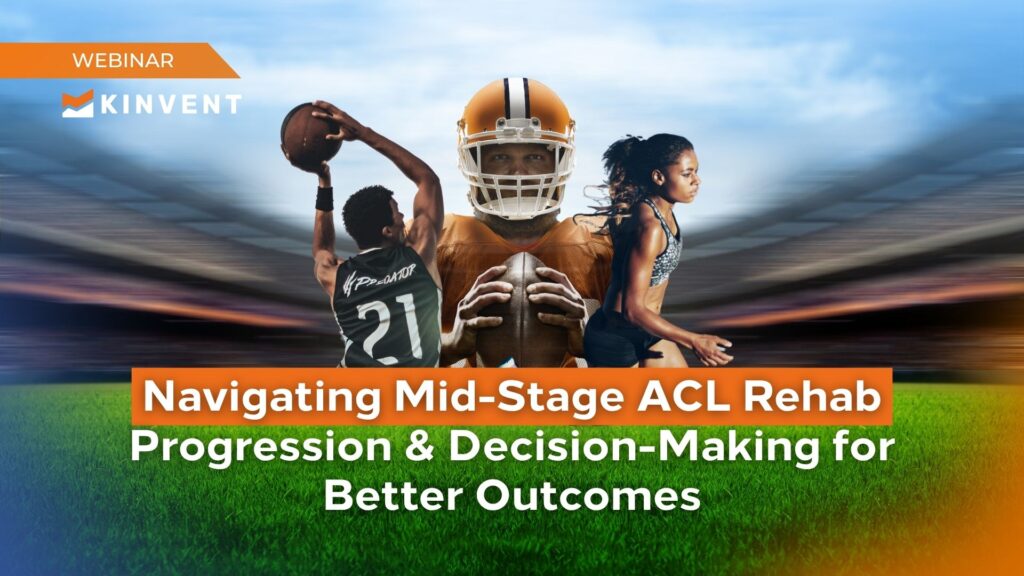Navigating Mid-Stage ACL Rehab Progression & Decision-Making for Better Outcomes with Alex Shafiro
Webinar Replay: Objective Data in Mid-Stage ACL Rehabilitation – A practical guide to using objective measures and technology to drive confident clinical decision-making and optimize recovery during the crucial mid-stage of ACL rehab.
👉 Gain expert-level strategies and a clear framework for managing the most critical phase of ACL recovery, for free.
The mid-stage of Anterior Cruciate Ligament (ACL) rehabilitation is often the most complex and uncertain part of recovery, serving as the “framing and foundation of the house” before the final “siding and roof material” of return-to-sport. This is the phase that can feel the most challenging for clinicians and patients alike: determining when and how to progress strengthening and dynamic activities while ensuring the patient is truly ready for the later stages. Whether your patient is a high-level athlete or a recreational individual, the risks of premature progression are high.
In this replay, Alex Shafiro, an orthopedic specialist and sports physical therapist who sees roughly 40 to 50 ACLs a year in his clinic, breaks down the challenges and provides practical, technology-supported strategies to transition patients towards return-to-sport confidently. You’ll learn how to implement both absolute (e.g., isometric, isokinetic, hamstring-quad ratio) and relative (e.g., maximum voluntary contraction for a specific exercise on a given day) objective data in every session to maximize loading and patient buy-in.
What You’ll Learn
✅ The importance of shifting the ACL rehab timeline to dedicate four to five months of focused effort during the middle stage, compared to the typically shorter protocol.
✅ How to classify and collect different types of data in rehabilitation: absolute measures (e.g., quad-hamstring ratio) vs. relative measures (e.g., MVC for a session).
✅ Practical examples of using portable technology (dynamometers, EMG) to assess and train quadriceps activation, speed, and power in the mid-stage.
✅ Strategies for monitoring and progressing key movements like weight-shifting, isometrics, and eccentric loading using biofeedback and objective limits.
✅ The power of combining force plates data with slow-motion video to objectively quantify symmetry deficits during dynamic movements like the countermovement jump (CMJ) and drive patient understanding.
✅ Key take-home points for gaining patient buy-in and using objective data as proof to both the patient and the physician/coach regarding readiness for progression and return-to-sport.
Why Watch the Replay
✔ Understand why the mid-stage is the foundation of a successful ACL recovery and why it requires more time and focus than often prescribed.
✔ Learn how to overcome common clinical obstacles like equipment cost and the time efficiency of data collection by using flexible and transient technology.
✔ Discover how to apply objective measures as often as every session, even multiple times per session, to guide loading and progression.
✔ Get actionable timelines for introducing key assessments like the quad-hamstring strength ratio and the countermovement jump (CMJ).
👉 Watch the full Navigating Mid-Stage ACL Rehab Webinar Replay now and build confidence in your most critical rehab decisions.
About the speaker
Alex Shafiro, PT, DPT, OCS, CSCS, SFG, is a highly experienced physical therapist and a board-certified Orthopaedic Clinical Specialist (OCS) with nearly two decades of clinical experience. He is currently in private practice, with previous experience working and managing the outpatient rehab for the sports clinic at the prestigious Hospital for Special Surgery. Alex specializes in sports medicine, focusing heavily on lower extremity rehab (hip and knee), athletic longevity, and performance, treating active individuals and athletes from amateur to professional levels. He has a particular interest in the integration of technology into the various stages of rehabilitation to improve outcomes and lectures nationally on sports medicine and orthopedics



